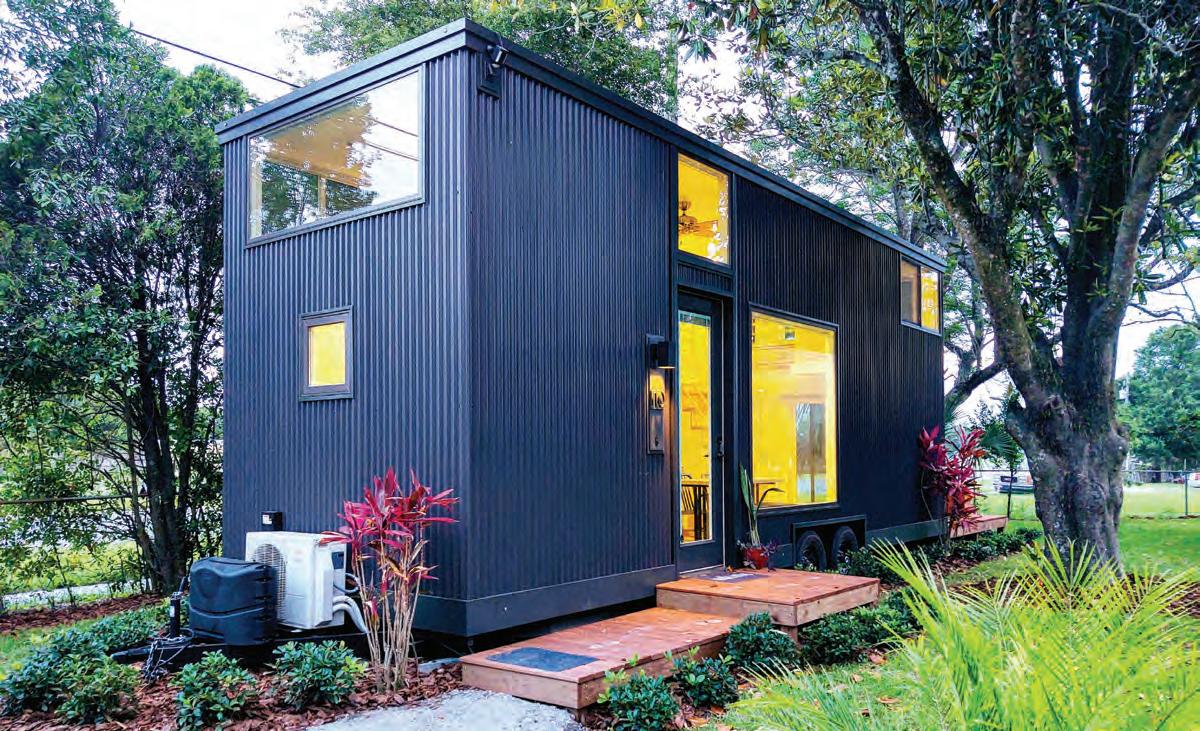
5 minute read
Dan Dobrowolski ’79 builds tiny houses
Living LARGE
Alum’s little neighborhood of tiny homes is taking off in big ways
By JOEY JOHNSTON, ’81
ON THE OUTSKIRTS OF TAMPA, people are living large in a village of tiny homes.
They are fully functional, handsome-looking dwellings, ranging from 350 to 600 square feet. Who’s in? Everyone from millennials to retirees, physicians to business owners to college professors. Tiny homes: An HGTV programming gimmick? More like an American phenomenon. “Our business is out of control and the demand is exponentially growing,’’ says Dan Dobrowolski, geography ’79, a TV meteorologist-turned-serial entrepreneur who developed ESCAPE Tampa Bay Village. It began in 2020 with 10 tiny homes on a secluded property in Thonotosassa, a semi-rural Tampa suburb far from the urban core, but still close to everything. When Phase Two is completed ESCAPE’s population will triple. Who knows where it goes from there? “It was growing at a rapid pace and COVID put gasoline on the fire,’’ Dobrowolski says. “People figured out in a hurry they didn’t want to be in an apartment building or condo, all jammed together. They wanted their own safe space. “People are figuring out they can live so much cheaper in something about 20 percent of the (normal) cost and it’s less than living in an apartment. Why would you not want to own it?’’ The next phase of homes in the little neighborhood will start at $120,000. Ray Pelaez, a digital marketing entrepreneur, gave up
– Dave Peterson
a Hyde Park apartment near downtown Tampa to move into his tiny home. The bedroom he still has at his parents’ 3,500-square-foot home is probably larger than his current 450-square-foot home at ESCAPE. But it doesn’t feel small.
“The way these places are laid out, the storage is great and I don’t feel like I have sacrificed anything,’’ he says. “I was talking to a buddy who said, ‘How’s the minimal living going?’ And I was like, ‘What do you mean?’
USF alumnus Dan Dobrowolski, geography ’79, developed ESCAPE Tampa Bay Village.
“At one time, I had a lot of space. Too much space. I was almost like a hoarder. I had a two-car garage literally filled to the brim with stuff. The downsizing forces you to realize what’s important in life. I feel liberated. My new dream is having a bunch of acres, plopping one of these houses in the middle, and being very comfortable.’’
For now, Pelaez is spending all the money he’s saving on a Tesla and a planned trip around the world.
“People are finding they can adjust their thinking, change the way they live and maybe be able to afford a bunch of more toys,’’ says Dave Peterson, ESCAPE’s development director. “It’s 21st Century living. Some people don’t want the big yard and all that maintenance. Our homes are beautiful, functional and versatile.’’
Fully assembled in Wisconsin and transported to Florida, they’re also classified as recreational vehicles, so they can be towed to a campground or other vacation spot.
“It just makes sense to jump out of the normal rat race that everybody is so used to,’’ Pelaez says.
That was Dobrowolski’s thinking nearly three decades ago when he left his television career for good and acquired the land to build Canoe Bay, a 300-acre getaway destination in


Above: The original ESCAPE Tampa Bay is sold out. Residents purchase their tiny homes and rent their lot.
Left: ESCAPE homes are available in a variety of designs. This one is Traveler XL.

northern Wisconsin. It’s a place to unplug, with cottages and tiny homes sprinkled among spring-fed lakes.
Dobrowolski also established ESCAPE vacation spots throughout the United States, but he always had his eye on Florida. He fondly remembered Tampa from his years at USF and his tenure as weekend meteorologist for WFLA-TV, Tampa’s NBC affiliate.
He dispatched Peterson to the prospective ESCAPE Tampa Bay Village location, telling him to “Make it scream Florida.’’ Peterson planted 49 palms on the property.
But the cutesy houses are the true attraction. Panoramic windows and other light-enhancing design features give them an open, spacious feeling, while hard marble cabinets and modern sheet-rock create a woodsy ambiance.
“I’m a big person physically, so if it doesn’t work for me, we don’t build it,’’ Dobrowolski says. “Everything functions like a normal house. It’s not downsized; it’s actually right-sized. Like any great architecture, it has a great design behind it. It should feel like something special. People see it and say, ‘I can live in here. I can stay here.’ It has space. We like space.’’
ESCAPE tiny homes are inspired by the architectural design of Frank Lloyd Wright, with plenty of work space, comfortable bedrooms and great kitchens, Dobrowolski says.
“You can spend your money on cars or traveling or experiences instead of rooms that you never see that you use to store things you don’t need. If you absolutely must have some of that stuff, I guess you rent some place to store it,” he says. “It makes sense for everyone. People think young people or retirees. Truthfully, our target customers are anyone with a pulse.”
Building critically acclaimed tiny houses and creating forward-thinking communities wasn’t the career path Dobrowolski had in mind at USF. He attended out of convenience – his family had moved from the Midwest to Sarasota, so it was nearby.
He has happy memories of his professors and the opportunities they encouraged. As it turned out, he tried plenty of them — from television to owning businesses to becoming a chef and starting a wine program at Canoe Bay.
He envisions an eventual move to Florida because he believes the ESCAPE Tampa Bay concept has great potential. “We’re building and shipping these homes constantly and the trucks are always moving,’’ Dobrowolski says. “It’s amazing. I love doing this. I can’t wait to see what happens next.’’
For now, he’s living large.


